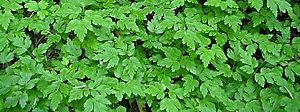Fernleaf goldthread facts for kids
Quick facts for kids Fernleaf goldthread |
|
|---|---|
 |
|
| Scientific classification | |
| Genus: |
Coptis
|
| Species: |
aspleniifolia
|
Coptis aspleniifolia, often called fernleaf goldthread or spleenwort-leaf goldthread, is a special plant. You can find it in the northern parts of British Columbia, in Alaska, and along the Cascade mountains in Washington. This plant loves to grow in temperate rainforests, which are cool, wet forests. It also grows in coniferous forests, which are forests with cone-bearing trees like pines and firs. You might see it in wet, boggy areas too. The fernleaf goldthread is a common plant in these places and it's not harmful or invasive.
This plant is an evergreen perennial, meaning it stays green all year and lives for many years. It usually grows between five and 30 centimeters tall. Its leaves look a lot like fern leaves, which is how it gets its name. They are dark green, shiny, and divided into many small parts. In the middle of spring, the fernleaf goldthread blooms with pale greenish-white or yellow flowers. Each stalk has two or three nodding flowers. These flowers have five to seven sepals (leaf-like parts that protect the bud) and five to seven thin petals. This plant is part of the buttercup family.
Why is it called Fernleaf Goldthread?
The plant gets its common name from two main things. First, its leaves look very similar to the leaves of a common fern. Second, if you peel back the roots, you'll find they are a bright, shiny golden color! This golden root is where the "goldthread" part of its name comes from.
What does it do for nature?
The fernleaf goldthread plays a few important roles in its natural home.
- Ground cover: It grows low to the ground, acting like a protective blanket.
- Keeps moisture: By covering the ground, it helps keep the soil moist and cool, especially during warmer times.
- Food for animals: Deer sometimes eat this plant, making it a food source for them.
See also
 In Spanish: Coptis aspleniifolia for kids
In Spanish: Coptis aspleniifolia for kids

